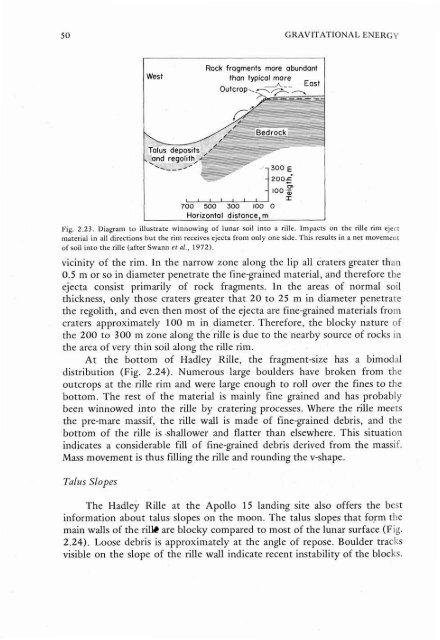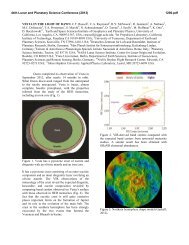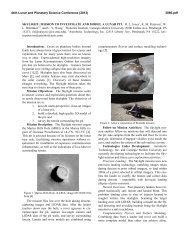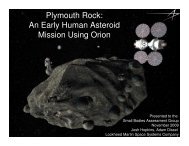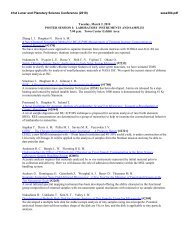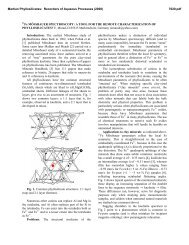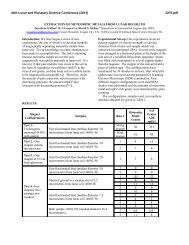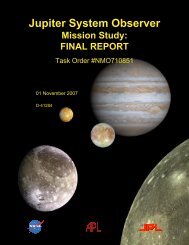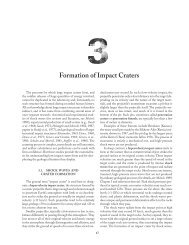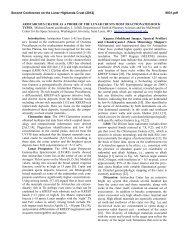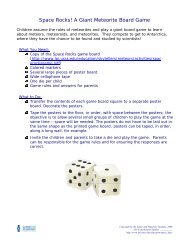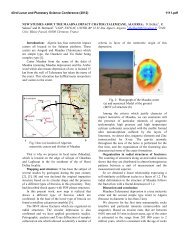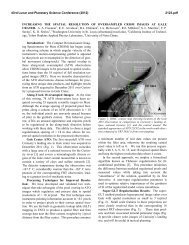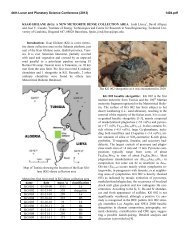Chapter 2: Energy at the Lunar Surface - Lunar and Planetary Institute
Chapter 2: Energy at the Lunar Surface - Lunar and Planetary Institute
Chapter 2: Energy at the Lunar Surface - Lunar and Planetary Institute
You also want an ePaper? Increase the reach of your titles
YUMPU automatically turns print PDFs into web optimized ePapers that Google loves.
Rock fragments more abundant<br />
West than typical mare<br />
- - East<br />
Outcrop.,.~p- ,<br />
Horizontal distance, m<br />
GRAVITATIONAL ENERGY<br />
Fig. 2.23. Diagram to illustr<strong>at</strong>e winnowing of lunar soil into a rille. Impacts on <strong>the</strong> rille rim eject<br />
m<strong>at</strong>erial in all directions but <strong>the</strong> rim receives ejecta from only one side. This results in a net movement<br />
of soil into <strong>the</strong> rille (after Swann et al., 1972).<br />
vicinity of <strong>the</strong> rim. In <strong>the</strong> narrow zone along <strong>the</strong> lip all cr<strong>at</strong>ers gre<strong>at</strong>er than<br />
0.5 m or so in diameter penetr<strong>at</strong>e <strong>the</strong> fine-grained m<strong>at</strong>erial, <strong>and</strong> <strong>the</strong>refore <strong>the</strong><br />
ejecta consist primarily of rock fragments. In <strong>the</strong> areas of normal soil<br />
thickness, only those cr<strong>at</strong>ers gre<strong>at</strong>er th<strong>at</strong> 20 to 25 m in diameter penetr<strong>at</strong>e<br />
<strong>the</strong> regolith, <strong>and</strong> even <strong>the</strong>n most of <strong>the</strong> ejecta are fine-grained m<strong>at</strong>erials from<br />
cr<strong>at</strong>ers approxim<strong>at</strong>ely 100 m in diameter. Therefore, <strong>the</strong> blocky n<strong>at</strong>ure of<br />
<strong>the</strong> 200 to 300 m zone along <strong>the</strong>'rille is due to <strong>the</strong> nearby source of rocks in<br />
<strong>the</strong> area of very thin soil along <strong>the</strong> rille rim.<br />
At <strong>the</strong> bottom of Hadley Rille, <strong>the</strong> fragment-size has a bimodal<br />
distribution (Fig. 2.24). Numerous large boulders have broken from <strong>the</strong><br />
outcrops <strong>at</strong> <strong>the</strong> rille rim <strong>and</strong> were large enough to roll over <strong>the</strong> fines to <strong>the</strong><br />
bottom. The rest of <strong>the</strong> m<strong>at</strong>erial is mainly fine grained <strong>and</strong> has probably<br />
been winnowed into <strong>the</strong> rille by cr<strong>at</strong>ering processes. Where <strong>the</strong> rille meets<br />
<strong>the</strong> pre-mare massif, <strong>the</strong> rille wall is made of fine-grained debris, <strong>and</strong> <strong>the</strong><br />
bottom of <strong>the</strong> rille is .shallower <strong>and</strong> fl<strong>at</strong>ter than elsewhere. This situ<strong>at</strong>ion<br />
indic<strong>at</strong>es a considerable fill of fine-grained debris derived from <strong>the</strong> massif.<br />
Mass movement is thus filling <strong>the</strong> rille <strong>and</strong> rounding <strong>the</strong> v-shape.<br />
Talus Slopes<br />
The Hadley Rille <strong>at</strong> <strong>the</strong> Apollo 15 l<strong>and</strong>ing site also offers <strong>the</strong> best<br />
inform<strong>at</strong>ion about talus slopes on <strong>the</strong> moon. The talus slopes th<strong>at</strong> form <strong>the</strong><br />
main walls of <strong>the</strong> rill& are blocky compared to most of <strong>the</strong> lunar surface (Fig.<br />
2.24). Loose debris is approxim<strong>at</strong>ely <strong>at</strong> <strong>the</strong> angle of repose. Boulder tracks<br />
visible on <strong>the</strong> slope of <strong>the</strong> rille wall indic<strong>at</strong>e recent instability of <strong>the</strong> blocks.


